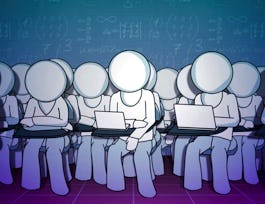Do your students spend too much (or too little) time learning, with disappointing results? Do they procrastinate in their study because it’s boring and they’re easily distracted? Are you working to make your teaching even more inclusive? Uncommon Sense Teaching will give you practical new insights that will help you solve these goals and challenges, and many more.

Offrez à votre carrière le cadeau de Coursera Plus avec $160 de réduction, facturé annuellement. Économisez aujourd’hui.


Uncommon Sense Teaching
Ce cours fait partie de Spécialisation Uncommon Sense Teaching



Instructeurs : Beth Rogowsky
Enseignant de premier plan
32 496 déjà inscrits
Inclus avec 
(579 avis)
Compétences que vous acquerrez
- Catégorie : Teaching
- Catégorie : diversity
- Catégorie : inclusive
- Catégorie : teaching strategies
Détails à connaître

Ajouter à votre profil LinkedIn
8 devoirs
Découvrez comment les employés des entreprises prestigieuses maîtrisent des compétences recherchées

Élaborez votre expertise du sujet
- Apprenez de nouveaux concepts auprès d'experts du secteur
- Acquérez une compréhension de base d'un sujet ou d'un outil
- Développez des compétences professionnelles avec des projets pratiques
- Obtenez un certificat professionnel partageable


Obtenez un certificat professionnel
Ajoutez cette qualification à votre profil LinkedIn ou à votre CV
Partagez-le sur les réseaux sociaux et dans votre évaluation de performance

Il y a 4 modules dans ce cours
This week’s material covers the deepest essence of how we learn—which can provide surprisingly helpful and practical insights for our teaching! When students are learning, ideas captured in students’ working memories are sent to long-term memory in the neocortex. One of our biggest challenges in learning is the diversity in size of learners’ working memory—that temporary holding place for new ideas we are thinking about. (We three instructors model these differences in working memory capacity, with Terry having high capacity, Barb low capacity, and Beth variable, depending on the material.) Some people can hold more information in working memory—these “racecar” learners might learn more quickly, but what they learn can go by in a blur—they can jump to conclusions and find it difficult to correct themselves when they make errors. “Hiker” learners with lesser capacity working memory may learn more slowly, but they can learn more deeply, and sometimes more creatively, as a consequence. They can also find it easier to be flexible and change their thinking when they are wrong. What this all means is that the different sizes of working memory can have their advantages and disadvantages. Scaffolded instruction is a key to being more inclusive, so we can reach all of our learners, not just the few who are easy to teach. We will also take a fresh view of active learning—those words, as you will discover, do not always mean what you think they mean!
Inclus
11 vidéos4 lectures2 devoirs2 sujets de discussion1 plugin
This week, we'll dive into the brain's two major "superhighways" of learning. The declarative pathway wends its way through the hippocampus and onto the neocortex. This pathway is for new information students are trying to figure out or learn. A tiny, fun, metaphorical choir will help you better understand how the hippocampus (a glib character named Hip!), the neocortex (a capacious singer named Neo), and working memory (the Conductor) all interact to help students learn declaratively. And you'll learn how Beth used this type of learning, along with the underlying, all-important consolidation processes—to help her recover her ability to read the words she can now speak so eloquently. The more mysterious procedural pathway involves information, skills, or activities that we use or do so often that we don't want to have to waste cognitive resources in having to think about them. Think that drill means kill? Think again—we teachers ignore the value of the procedural pathway at our peril. As we'll discover, smartly done drill leads to skill! We'll also cover important issues related to lack of focus, including task switching, dual tasking, and continuous partial attention. But unrelenting focus isn't always the answer—as we'll see, there are tricks to help students get around the cognitive fixation that can cause them so many problems on tests. Finally, we'll show how using a neural approach to understanding the effects of your teaching can also help you to understand the value of seemingly unrelated ideas and approaches like physical exercise, and of metaphor, when it learning. It's going to be a fun, action-packed week!
Inclus
9 vidéos2 lectures2 devoirs1 évaluation par les pairs1 sujet de discussion
This week, we dive into one of students' most common issues with their studies—procrastination. A common tool for business, the Pomodoro Technique, turns out to be also useful to help students of all ages focus their meditation. This is because the Pomodoro Technique makes masterful use of the brain's focusing and relaxing modes of thinking. Judicious focusing and relaxing of one's thoughts is also a great way to figure out difficult or frustrating concepts or problems. But when it comes to studying, it's important not only to focus and relax, but also to step back and look at the big picture of where the studies are headed. Is the common career advice for students to "follow your passion" always the best advice? And there are other bigger picture issues related to learning to help ensure our students approach their studies, projects, and tests with the best possible attitude and preparation
Inclus
10 vidéos2 lectures2 devoirs
Do children learn differently than adults? Yes they do, and this week's insights show us how our brains change as we mature. These changes mean that certain approaches that work great for our youngest students aren't necessarily appropriate for middle and high school students. Looking at learning from an evolutionary perspective helps us to understand why some types of learning are natural and easy, while other forms can be far more difficult. What are some of the best ways to tackle teaching the more-difficult-to-learn material? That's what this culminating week of our first MOOC in the Uncommon Sense Teaching Specialization is all about!
Inclus
7 vidéos3 lectures2 devoirs1 évaluation par les pairs
Instructeurs

Offert par
Recommandé si vous êtes intéressé(e) par Education

Arizona State University

UNSW Sydney (The University of New South Wales)

Commonwealth Education Trust

Imperial College London
Pour quelles raisons les étudiants sur Coursera nous choisissent-ils pour leur carrière ?




Avis des étudiants
Affichage de 3 sur 579
579 avis
- 5 stars
91,06 %
- 4 stars
7,04 %
- 3 stars
1,03 %
- 2 stars
0,51 %
- 1 star
0,34 %

Ouvrez de nouvelles portes avec Coursera Plus
Accès illimité à plus de 7 000 cours de renommée internationale, à des projets pratiques et à des programmes de certificats reconnus sur le marché du travail, tous inclus dans votre abonnement
Faites progresser votre carrière avec un diplôme en ligne
Obtenez un diplôme auprès d’universités de renommée mondiale - 100 % en ligne
Rejoignez plus de 3 400 entreprises mondiales qui ont choisi Coursera pour les affaires
Améliorez les compétences de vos employés pour exceller dans l’économie numérique
Foire Aux Questions
Access to lectures and assignments depends on your type of enrollment. If you take a course in audit mode, you will be able to see most course materials for free. To access graded assignments and to earn a Certificate, you will need to purchase the Certificate experience, during or after your audit. If you don't see the audit option:
The course may not offer an audit option. You can try a Free Trial instead, or apply for Financial Aid.
The course may offer 'Full Course, No Certificate' instead. This option lets you see all course materials, submit required assessments, and get a final grade. This also means that you will not be able to purchase a Certificate experience.
When you enroll in the course, you get access to all of the courses in the Specialization, and you earn a certificate when you complete the work. Your electronic Certificate will be added to your Accomplishments page - from there, you can print your Certificate or add it to your LinkedIn profile. If you only want to read and view the course content, you can audit the course for free.
If you subscribed, you get a 7-day free trial during which you can cancel at no penalty. After that, we don’t give refunds, but you can cancel your subscription at any time. See our full refund policy.

